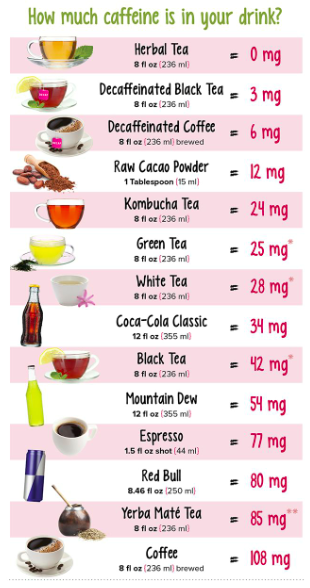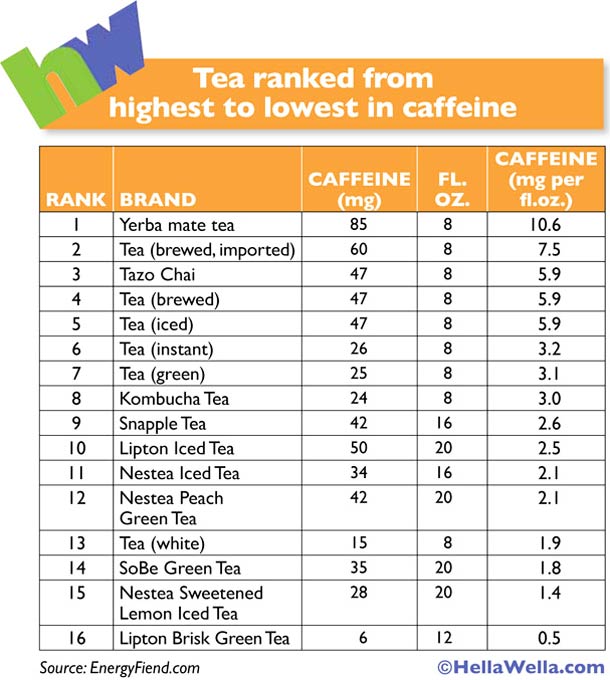How much caffeine is in my tea?
I wish there was a simple answer to this question. It would be ever so cool if I could just say, “black tea has 45 mg of caffeine per 8-ounce cup.” In fact, a number of people say it actually is that simple. Unfortunately, they’re wrong.
This graph came from the front page of the eZenTea website:
And this one is from a tweet from SanctuaryT (it said, “Finally, the truth about #tea and #caffeine!”):
They make it pretty simple, right? But that’s not very useful when they disagree with each other! The first chart shows the caffeine in green tea at 20 mg/cup and white tea at 10 mg/cup, showing that white tea has half as much caffeine as green tea. The second chart shows green tea at 25 mg/cup and white tea at 28 mg/cup, indicating that white tea has 12% more caffeine.
Then we get confusing (and frankly pretty silly) charts like this one from HellaWella:
All three charts have green tea in the same basic range (20-25 mg/cup), but the HellaWella chart breaks out black tea (which is 40-42 mg/cup in the other two charts) into “brewed tea” at 47 mg/cup and “brewed imported tea” at 60 mg/cup. Huh? “Imported”? HellaWella’s “about” page doesn’t say what country they’re from, but I’m going to guess from the spellings that they’re from the U.S. Sure, there are few small tea plantations in the U.S., but I would venture to guess that approximately zero percent of casual tea drinkers have ever had a domestically grown tea. In America, pretty much all tea is “imported.”
So why the discrepancies?
Because the people making these charts (a) don’t explain their methodology and/or (b) don’t understand tea.
As I explained in my three-part caffeine series (here’s part 1), green, white, oolong, black, and pu-erh tea all come from the same species of plant (Camellia sinensis), and in some cases, the same actual plant. We carry a black and a green Darjeeling tea that are picked from the same plants, but processed differently. No part of that process creates or destroys caffeine.
Let me make that clear: let’s say you pick a bunch of tea leaves on your tea farm. You divide them up into four equal piles. You turn one pile into green tea, one into white tea, one into black tea, and one into oolong tea. When you’re done, you make a cup of tea from each. Assuming you use the same water at the same temperature, use the same amount of leaf per cup, and steep them for the same time, they will all have the exact same amount of caffeine.
If that processing doesn’t change the caffeine content, what does?
- The part of the plant that’s used. Caffeine tends to be concentrated in the buds and leaf tips. A high-quality golden or white tea made from only buds will have more caffeine than a cheap tea made with the big leaves farther down the stem.
- The growing conditions. Soil, rainfall, altitude, and many other factors (collectively known as terroir) all affect how much caffeine will be in the tea leaves.
- The time of year the leaves were harvested. Tea picked from the same plants several months apart may have dramatically different amounts of caffeine.
- How long you steep the tea. The longer those leaves sit in the water, the more caffeine will be extracted into your drink.
- How much leaf you use in the cup. Use more leaves, get more caffeine.
- How big the cup is. This seems ridiculously obvious, but it’s something a lot of people miss. Anyone who went to elementary school in the United States knows that one cup = eight ounces. However, a four-cup coffee maker doesn’t make 32 ounces (8 x 4); it makes 24 ounces. They decided their coffee makers sound bigger if they use six-ounce cups.
Even if you and I measure the same amount of leaf out of the same tin of tea, your cup might have twice the caffeine of my cup, depending on how we like to fix it. Unless we both precisely followed the ISO 3103 standard for brewing the perfect cup of tea.
Unfortunately, the lab tests to assess caffeine content are expensive, so most tea shops never test their teas. On top of that, people can’t seem to agree on how to brew the tea they are testing. I read one study where every tea was brewed for five minutes in boiling water. That’s consistent, but it’s not realistic. You don’t brew a Japanese green tea that way, or you’ll have a bitter, undrinkable mess. Another, by Kevin Gascoyne, tested tea as most people drink it (e.g., black tea in boiling water, white tea in cooler water). That’s better but even still, Kevin’s way of brewing a particular tea may not be the way I do it.
The bottom line is that every tea is different. Very different. In fact, Kevin tested two different sencha teas and one had four times the caffeine of the other. If someone shows you a handy-dandy chart that indicates exactly how much caffeine a cup of tea has (as opposed to showing a range), it’s wrong.
While writing this blog post, I was drinking green rooibos from South Africa, which has no caffeine at all. It is a non-oxidized “redbush” tea has a much softer flavor than red rooibos. I brewed this cup for 4:00 using boiling water. It’s a remarkably forgiving drink, and I’ve steeped it for as long as 10 minutes without ruining it. It’s usually good for at least two infusions.
Posted on 30 January 2015, in Caffeine and tagged Caffeine, Kevin Gascoyne. Bookmark the permalink. 6 Comments.




Nice one Gary!
Thanks, Kevin! I hope I’ll see you at World Tea Expo this year. On special occasions, I’m still enjoying bits of the Laotian Phong Sali 2011 Pu-erh, although I think it still needs a couple of years to fully mature.
I couldn’t have put it better myself! The frustrating part is that when I try to tell people all of this, they don’t believe me because they see these charts everywhere.
I know, Nicole! I already had a comment from someone who read as far as the first chart in this post and stopped before I got to the part where I said it was wrong! I think I need to get to work on an infographic of my own.
Hi Gary!
This post is great, thanks for taking the time to create it.
I’m beginning to cultivate yaupon plants for tea and would like to start testing how caffeine levels vary from plant to plant and with different growing techniques. Could you tell me the best, most cost efficient way to test caffeine levels?
Unfortunately, John, I know of no way to do that test yourself. Unless there are some new tests I don’t know about, you’re going to have to pay a lab to do it for you. The last time I checked, the tests run about $2,000 per sample.